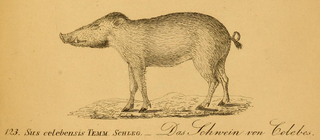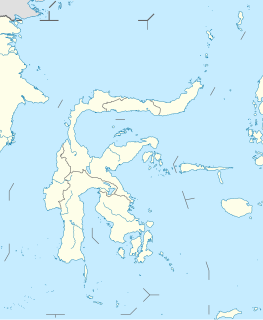The Sulawesi woodcock also known as Celebes woodcock, is a medium-sized wader. It is larger and darker than Eurasian woodcock but with small reddish spots.

The North Sulawesi babirusa is a pig-like animal native to Sulawesi and some nearby islands in Indonesia. It has two pairs of large tusks composed of enlarged canine teeth. The upper canines penetrate the top of the snout, curving back toward the forehead. The North Sulawesi babirusa is threatened from hunting and deforestation.

The babirusas, also called deer-pigs are a genus, Babyrousa, in the swine family found in Wallacea, or specifically the Indonesian islands of Sulawesi, Togian, Sula and Buru. All members of this genus were considered part of a single species until 2002, the babirusa, B. babyrussa, but following the split into several species, this scientific name is restricted to the Buru babirusa from Buru and Sula, whereas the best-known species, the north Sulawesi babirusa, is named B. celebensis. The remarkable "prehistoric" appearance of these mammals is largely due to the prominent upwards incurving canine tusks of the males, which actually pierce the flesh in the snout.

Lore Lindu National Park is a protected area of forest on the Indonesian island of Sulawesi, in the province of Central Sulawesi. The Indonesian national park is 2,180 km² covering both lowland and montane forests. It provides habitat to numerous rare species, including 77 bird species endemic to Sulawesi. The national park is designated as part of the UNESCO World Network of Biosphere Reserves. In addition to its rich wildlife, the park also contains megaliths dating from before 1300 AD.

The Celebes warty pig, also called Sulawesi warty pig or Sulawesi pig, is a species in the pig genus (Sus) that lives on Sulawesi in Indonesia. It survives in most habitats and can live in altitudes of up to 2,500 metres (8,200 ft). It has been domesticated and introduced to Papua New Guinea.

Bogani Nani Wartabone National Park is a 2,871 km2 (1,108 mi2) National Park on Minahassa Peninsula on Sulawesi island, Indonesia. Formerly known as Dumoga Bone National Park, it was established in 1991 and was renamed in honour of Nani Wartabone, a local resistance fighter who drove the Japanese from Gorontalo during World War II. The park has been identified by Wildlife Conservation Society as the single most important site for the conservation of Sulawesi wildlife and is home to a large number of species endemic to Sulawesi.
The Sulawesi yellow bat is a species of vesper bat. It is found only in Indonesia.
The Celebes shrew-rat is a species of rodent in the family Muridae. It is found only in Sulawesi, Indonesia. Its natural habitat is subtropical or tropical dry forests. It is threatened by habitat loss.

The Celebes rat is a species of rodent in the family Muridae. It is found only in Sulawesi, Indonesia.

The dark-eared myza, also known as the lesser streaked honeyeater, is a species of bird in the family Meliphagidae. It is endemic to the island of Sulawesi in Indonesia. There are two subspecies, Myza celebensis celebensis which is found in mountainous parts of northern, central and southeastern Sulawesi, and Myza celebensis meridionalis from mountains in southern Sulawesi.

The Sulawesi dwarf cuscus is a species of arboreal marsupial in the family Phalangeridae endemic to Sulawesi and nearby islands in Indonesia. It inhabits tropical moist lowland forest and is nocturnal, folivorous and usually found in pairs. S. celebensis is threatened by hunting and deforestation.

Strigocuscus is a nocturnal, arboreal marsupial genus in the family Phalangeridae found only in Sulawesi and some of its surrounding small offshore islands. Due to the unique biogeography of Sulawesi giving sub-regions of endemism, it is likely that there are several different species or subspecies as yet to be described by science. So far, the genus contains the following species:

The Sulawesi flying fox or Sulawesi fruit bat is a species of megabat endemic to Indonesia. It is classified as "Vulnerable" by the IUCN due to unsustainable levels of hunting.

The Sulawesi rousette is a species of megabat in the family Pteropodidae endemic to Sulawesi, an island in Indonesia.
Oryzias celebensis, the Celebes medaka, fish in the family Adrianichthyidae. It is endemic to rivers, streams and lakes on the Indonesian island of Sulawesi and one river in East Timor.
Elephas celebensis or the Sulawesi dwarf elephant is an extinct species of elephant.

The Sulawesi harpy fruit bat is a species of megabat in the family Pteropodidae. It is endemic to Indonesia.
"This species occurs in Sulawesi, Indonesia. It is also found in Soloi on Buton island in Indonesia. It occurs from sea level up to 2,120m asl or probably higher. This species is not common. In 2002, three individuals were captured at a single locality. Population Trend ↓ Decreasing. It seems to require good forest, but has also been recorded from cocoa plantations. Soloi individuals were caught over a river in undisturbed forest. Roosting habits are not known, but this species is not likely to be a cave dweller. Hunting for sale at market, and forest loss due to expanding agriculture and logging represent major threats to this species. This species is known to occur in Domoga-bone National Park."












